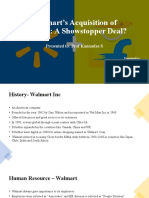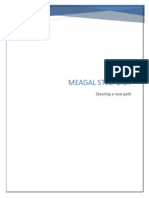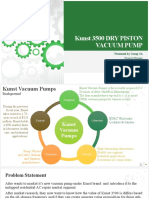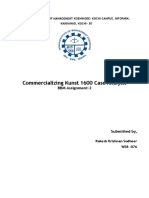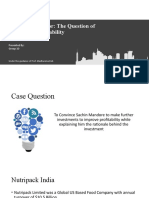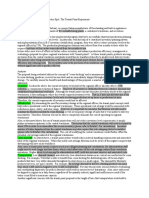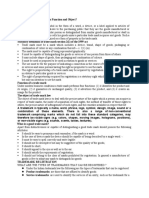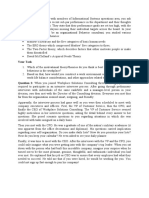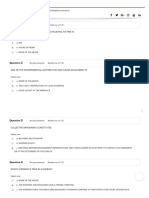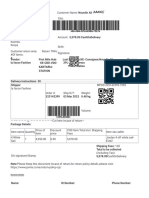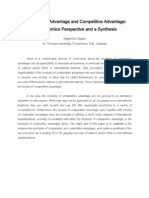Merloni Elettrodomestici SpA Case Analysis Ver 1.2
Merloni Elettrodomestici SpA Case Analysis Ver 1.2
Uploaded by
Subodh203Copyright:
Available Formats
Merloni Elettrodomestici SpA Case Analysis Ver 1.2
Merloni Elettrodomestici SpA Case Analysis Ver 1.2
Uploaded by
Subodh203Copyright
Available Formats
Share this document
Did you find this document useful?
Is this content inappropriate?
Copyright:
Available Formats
Merloni Elettrodomestici SpA Case Analysis Ver 1.2
Merloni Elettrodomestici SpA Case Analysis Ver 1.2
Uploaded by
Subodh203Copyright:
Available Formats
Logistics & Supply Chain Management
Batch : PGCBM – 16
Case Study : Merloni Elettrodomestici Spa: The
transit point analysis
Course : Strategic Management
Professor’s Name : T.A.S. Vijayaraghavan
Student’s Name : Subodh Kumar (DB09064, 2215536)
Isac Thomas (DB09039, 2215537)
Lins Paul (DB09099, 2215449)
Sudhir K Verma (DB09054,2215446)
Study Centre : Sector 64, Noida
LSCM Case Study_PGCBM-16 2010 1
1. Introduction:
The purpose of this case study analysis is to evaluate the benefits or repercussion of cross docking
technique for Merloni Elettrodomestici Spa Company across its all regional warehouses.
Merloni had already implemented programs that had successfully shortened production-planning
lead times and decreased inventory levels. To further reduce inventory and enhance production
efficiency, management was evaluating a proposal to replace regional warehouses with "transit-
points". At these transit points, products arriving on trailers from the central warehouse and plants
would then be transferred directly to smaller local delivery trucks. The primary issue being
assessed then was the viability of the transit point solution and its effectiveness in improving
efficiency and reducing costs. The secondary issue was the provision of an exhibition center in
the Milano area without significant risks to product delivery.
2. Brief Information on Merloni :
Merloni Elettrodomestici SpA is a major Italian manufacturer of domestic appliances. The
company has four manufacturing subsidiaries as
a). Merloni Elettrodomestici (domestic appliances): It manufactured both freestanding and
build-in appliances like washing machine etc. It had five plants in Italy. This unit had highest
(75%) sales revenue share in 1984.
b). Merloni Igienico Sanitari (Bath and heating products): It manufactured water heaters, bath
tubs etc. This unit had 20% revenue share in 1984 for overall group.
c). Merloni Casa (Build-in kitchen and furniture): It designed, manufactured and installed built-in
kitchen and bath furniture.
LSCM Case Study_PGCBM-16 2010 2
d). Merloni Progetti (industrial projects): This unit licensed Merloni technology and oversaw the
construction of plants to produce products locally in other countries.
Besides above four plants Merloni had a centralized warehouse and seventeen warehouses across
Italy.
3. Facts from existing system:
A). Company had dedicated single plant for one product. Company had reliable pool of semi-
skilled people near the plants. Company’s response for demand fluctuation could be good.
B). Company emphasized on decentralized operations.
C). Some retailers generally received 24-hours delivery of product that was in stock at nearest
warehouse. Otherwise two to six days were required to replenish the stocks from central
warehouse to regional warehouse to retailers.
D). Shipment delays occurred time to time for variety of uncontrollable and controllable reasons.
Under such conditions small retail customers with no or little stocks were impacted most
leading to unsatisfied consumers. It affected Merloni’s responsiveness and efficiency both.
E). No built-in appliances were distributed thru regional warehouses.
F). Each plant had its own warehouse area to store raw materials, finished goods etc. It was to
increase responsiveness at plant level.
G). Company used to give discounts to customers ordering full-truckload thru plants. Otherwise
the orders were fulfilled from regional or central warehouses. This was to avoid higher
transportation cost while delivering not full truck load to customers.
H). Shipments were sent to regional warehouses from central warehouse once accumulated orders
leaded to full-truckload. It increased the efficiency at transportation as a SCM channel.
I). Regions located more than one day’s journey from central warehouse held higher inventory
levels to buffer demands over longer replenishment lead times.
J). Merloni had reliable contracts with operators in each regions.
K). After sales service was a major function with responsibility for sales planning, physical
distribution and warehouse management, customary maintenance and repair activities.
L). Company managed a centralized inventory planning system. It implemented of an A-B-C
inventory classification program. They were able to reduce inventory levels at the regional
warehouses by 75%. The production planning time horizon was also reduced from four
months to three while the required lead-time to firm orders was reduced from two months to
one.
4. Analysis of the case
The below section deals with the analysis of Transit point experiment and its benefits. It also
explains costs to company if implemented the same technique at all regional warehouses.
Here cross-docking refers to moving product from a manufacturing plant and delivering it
directly to the customer with little or no material handling in between. In the current case the
company ran a pilot project for cross docking at Milano warehouse loading area.
The discussion is given below in some standard framework.
LSCM Case Study_PGCBM-16 2010 3
4.1. Key Logistics Channel Impacted
The following picture depicts the key logistics channel for Merloni SCM. We will discuss
the channels one by one.
4.1.1. Retailers/Customers
The customers had to be educated that if they want to receive an order delivered by
following day, they had to order before 3 PM. The company did not want to
increase the transport facility in case of high demands. Instead it would ask
customers to expect some delay in order replenishment. This will definitely create a
LSCM Case Study_PGCBM-16 2010 4
negative effect on the customers. Here Merloni preferred efficiency to
responsiveness.
In the existing system over 65% of products were delivered within 24 hours,
directly from the regional warehouses. Rest 35% of products was shipped from
the central warehouse with a two to six day delivery times. Eliminating inventories
at regional warehouses would increase the delivery time for all products to two to
six days.
Further delays due to product damage could potentially double the delivery times.
The significant increase in lead time will certainly adversely affect customer-
satisfaction.
Although the two months trial that took place between the central warehouse and
Milan was successful, the distance between the two locations was relatively small
relative to the distance to the other regions.
Company decided a daily trailer-load of product from central warehouse to transit
point. Daily deliveries to some of the regions inaccessible via ground transport
were neither possible nor efficient. The company may need higher tracking facility
for other regional warehouses.
So we see that there is a trade off between responsiveness and efficiency and
company preferred efficiency.
4.1.2. Regional Warehouses
Merloni’s objective was to remove all regional warehouses and implement cross
docking facility. By doing so, the company would save money.
The sheet at appendix gives the cost to run all seventeen warehouses.
At this channel the company was trying to work on both responsiveness and
efficiency.
4.1.3. Cross Docking Facility
Although the company had planned to replace warehouses by cross docking facility,
the cost of maintaining it could be significant. These operational cost savings would
be associated with reduction in space, utility, and labor usage.
However, Merloni would still need to maintain the facilities needed for cross-
docking as well as temporary storage of units that it was unable to delivery
immediately.
As per Mr. Bosi the total operating costs might come down to 20% if company was
able to suspend warehouse lease payments and discharge warehouse employees.
The company would better off by allowing cross docking.
At this channel the company was trying to work on both responsiveness and
efficiency.
4.1.4. Central Warehouse
LSCM Case Study_PGCBM-16 2010 5
The use of transit points would not reduce inventory level requirements. It would
push inventories upstream to the central warehouse.
The impact of removing Milano warehouse would increase the load on central
warehouse by 2.71%. But by removing all regional warehouses would need central
warehouse to expand by about 32% in order to accommodate this excess inventory.
Please refer to the attach sheet at appendix for details.
Increased number of trailer departures from the central warehouse would also
require that extra shipping docks be installed. The cost of modifying the central
warehouse would further offset the potential cost savings realized at the regional
warehouses.
4.1.5. Plant and its inventory
As per the case – “To further reduce inventory levels and enhance production
efficiency, Dr. Merloni wanted to streamline Merloni’s distribution system;
introduce more flexibility into the production process (by reducing set-up times to
economically attain shorter run sizes); shorten the production planning period first
to eight weeks, then to four weeks; and institute a “distribution resource planning”
program to translate product distribution forecasts into production planning needs.
The new transitpoint concept seemed to be a vital component of the vision; testing
the concept’s viability would be the first step toward the achievement of that goal.
This is what company management set out to do in January and February 1986.”
It means that the plants would be more efficient leading to cost savings.
Scraping the regional warehouses may also impact the inventory maintained at the
plant site. This could lead to some investment and maintenance at the plant site.
4.2. Key Logistics Activity Impacted
Some of the key logistic activities as given below would also be impacted.
Although much of the impact is already discussed in section 4.1. We will discuss
some of the activities in brief.
LSCM Case Study_PGCBM-16 2010 6
4.2.1. Demand forecasting/planning
The Company would need advance demand forecasting and planning techniques
to avoid cost of sales and lost sales. The efficiency of the system will be
measured by tacking the problem of spur increase in demand in the month of
August. As the company is more focus on efficiency, it should make sure that the
cost of lost sales should not be very large.
4.2.2. Inventory Management
Current inventory levels held at the regional offices were already 75% lesser in
comparison to historical figures. This level of inventory was established based
on customer demands and constrained by production lead-times. Although the
transit point concept would eliminate inventory stocks at the regional
warehouses, it could not reduce the overall required inventory levels. Therefore,
the current requirements of inventory would not be affected.
4.2.3. Logistics Communications
The Company would require advance IT systems to integrate the demand forecast
with all the logistic channels. Any instance of channels not being in sync would
cost the company heavily.
Good and reliable information flow across the entire supply chain. In the current
case it was distribution crossdocking where the crossdock itself allocates material
to its RWH.
4.2.4. Labor and Staff
The transit point system would reduce material handling requirements and
associated labor at the regional warehouses. Although it would result as cost-
LSCM Case Study_PGCBM-16 2010 7
savings, Merloni should be aware of the negative impacts that downsizing would
have on its workforce at other places.
The major operational cost for crossdock is the labor cost. Hence, the system
performance is optimized by seeking to maximize the throughput of the
crossdock operations by establishing an efficient freight flow.
As given in the case, the company had access to semi skilled labors. A transit
point system requires much more diligent planning and coordination. The
company would require skill labors which would cost it significantly. Or
providing training to existing labors would also cost it.
The administration staff might need to work longer and later hours, which could
offset some of the cost savings realized from warehouse operations. Higher
stress levels among the administration staff could also increase turnover and
associated costs.
4.2.5. Traffic and Transportation
The success of cross docking depends upon low demand-variance and relatively
close distribution distances. However, the demands for Merloni’s products were
quite variable. For example, the average demand for the free-standing products
could shoot from about 1,000 units in August to over 12,000 in September.
This could present serious problems to planning and coordinating shipments, the
peak in demand could result in serious service disruptions. Also, since products
had to be shipped to regions on a daily bases, regardless of the quantity ordered,
significant loss would result if the trailer-truck was not filled to maximum
capacity.
5. Recommendation
After studying the case we can propose following few alternatives for increasing the efficiency of
its distribution network while maintaining or increasing the responsiveness of the SCM.
Transit Point Only at Milan
The trail at Milan was successful. There were some trade-offs for that.
From the case study it is clear that Mr. Bosi’s work involved significant manual work. The
company should had used advance logistics information system like “Total Asset Visibility
(TAV)”, which gives real time visibility at any time; for anyone in the supply chain can identify
where inventory is, its exact location, and if it is promised to a customer. The company should
create and manage the experience curve for using cross docking facility for some time.
The conversion of the Milano warehouse into an exhibition center could lead to sales and
marketing strategic advantage. One alternative would be to continue serving the region through a
transit point. The current distribution network could then be maintained for the remaining
regions. Although this alternative would not address the primary issue (efficiency of the
distribution network as a whole), it would allow Merloni to continue operating its exhibition
center without significant risks to product delivery.
LSCM Case Study_PGCBM-16 2010 8
Transshipment
Merloni used to replenish region warehouse directly from central warehouse. It could use the
concept of transshipment to increase its performance on efficiency front. As given in the case
study, regional warehouse are of different capacity. So, the company could use some of the bigger
warehouses to fill other smaller warehouses or nearby warehouses as and when required. This
could also give Merloni some flexibility on delivering the products and increase in
responsiveness. Many distribution resource-planning (DRP) software can be programmed to
automatically choose optimum routes if they are provided with necessary information about
route-specific transport costs and warehouse specific inventory storage and operational costs.
Combination of Transshipment and Cross Docking
Merloni could implement the concept of transshipment and measure its effect on responsiveness
and efficiency for its supply chain. Had the result found successful it could continue Milano as
transit point and implement transshipment concepts at some of the regional warehouses. It had to
see where it is more cost-effective; a regional office could be converted to a transit point as well
as receives shipments from another regional office.
Recommendation and Implementation
After analyzing the case study from different angle, taking responsiveness and efficiency at focus
it is recommended that Merloni should not deploy the transit point concept across all the regional
offices. Instead it could resort to other alternatives as given above.
After careful analysis of the primary issue and the critical factors, the recommendation is not to
deploy the transit point concept across all the regional offices. For the reasons explained above
(please refer Analysis), doing so will increase average product delivery times and adversely affect
customer satisfaction. At the same time, the cost-savings realized from conversion of warehouses
to transit points may be offset by higher costs of transportation, costs of modifying the central
office, and cost of lost sales due to customer dissatisfaction.
The third alternative explained above, however, addresses the primary issue. It leverages the
benefits of the transit point concept as well as that of transshipment. Furthermore, it ensures that
the Milano warehouse continues to operate as an exhibition center for Merloni's clients.
In order to implement this alternative, careful analysis of transportation costs between different
regions as well as operational costs of carrying inventory in each region must be determined.
This data can then be used in combination of a linear programming solution or a DRP software
capable of determining the optimum distribution and delivery solution for maximizing efficiency
and minimizing costs and delivery times.
Appendix
http://www.slideshare.net/rivetmoscow/cross-docking-challenges-in-regional-growth-environment
http://www.echeat.com/essay.php?t=27487
LSCM Case Study_PGCBM-16 2010 9
Merloni
Elettrodomestici SpA.xls
LSCM Case Study_PGCBM-16 2010 10
You might also like
- Sec A - Group 14 - Migros Turkey - Scaling Online OperationsDocument6 pagesSec A - Group 14 - Migros Turkey - Scaling Online OperationsSumitNo ratings yet
- Merloni Case - Group 1Document11 pagesMerloni Case - Group 1Prasanta Mondal100% (2)
- This Study Resource Was: Case Study On Raymond: Design of Warehouse Operations SBR-03Document3 pagesThis Study Resource Was: Case Study On Raymond: Design of Warehouse Operations SBR-03Rahul Yogi100% (1)
- Apollo CasseaDocument4 pagesApollo CasseaTara Lewis80% (5)
- SCM (Case Study 4)Document2 pagesSCM (Case Study 4)roshanNo ratings yet
- Group 3 - Manage Blood at VHS Blood BankDocument8 pagesGroup 3 - Manage Blood at VHS Blood BankRohan Lunawat100% (2)
- Questions For Singapore PostDocument8 pagesQuestions For Singapore PostAnirudh GuptaNo ratings yet
- Supply Chain Management: Merloni Transit Point ExperimentDocument5 pagesSupply Chain Management: Merloni Transit Point ExperimentSaunak SaikiaNo ratings yet
- Group 2 LTCLDocument6 pagesGroup 2 LTCLShubham Srivastava0% (3)
- Commercializing The Kunst 1600 Dry Piston Vacuum PumpDocument3 pagesCommercializing The Kunst 1600 Dry Piston Vacuum Pumpsaikat sarkar100% (1)
- SPE 77673 Integrated Reservoir Characterization and Simulation For Reservoir Management Using A Web-Based Collaborative Technical Workflow ManagerDocument9 pagesSPE 77673 Integrated Reservoir Characterization and Simulation For Reservoir Management Using A Web-Based Collaborative Technical Workflow ManagerOsvaldoNo ratings yet
- Case Study 4: Mcdonald India:Optimizing The French Fries Supply ChainDocument3 pagesCase Study 4: Mcdonald India:Optimizing The French Fries Supply Chainneha reddyNo ratings yet
- Merloni Transit Point AnalysisDocument8 pagesMerloni Transit Point AnalysisSchwayb Javid100% (2)
- Merloni-Tranist Point ModelDocument6 pagesMerloni-Tranist Point ModelUmair Chishti100% (1)
- Merloni Elettrodomestici Spa: The Transit Point Experiment: SCM - 2 Group 12Document8 pagesMerloni Elettrodomestici Spa: The Transit Point Experiment: SCM - 2 Group 12Prasoon SudhakaranNo ratings yet
- Merloni Elettrodomestici Spa: The Transit Point Experiment: Supply Chain ManagementDocument5 pagesMerloni Elettrodomestici Spa: The Transit Point Experiment: Supply Chain ManagementSaumya GautamNo ratings yet
- Walmart's Acquisition of FlipkartDocument10 pagesWalmart's Acquisition of FlipkartAnuj SohaniNo ratings yet
- MDCM, Inc. (A) : IT Synchronization StrategyDocument5 pagesMDCM, Inc. (A) : IT Synchronization StrategyTalha MehmudNo ratings yet
- Irizar Case MASTERDocument13 pagesIrizar Case MASTERKarthik PittsburghNo ratings yet
- Grp5 SecB FormPrintDocument4 pagesGrp5 SecB FormPrintshubhamagrawal1994100% (3)
- Case: Commercializing The Kunst 1600 Dry Piston Vacuum Pump: Submitted By: Ratandeep Burman - PGP/21/346Document3 pagesCase: Commercializing The Kunst 1600 Dry Piston Vacuum Pump: Submitted By: Ratandeep Burman - PGP/21/346SK CHANDANo ratings yet
- Wills-Lifestyle-In-India-Case (Retail SCM Planning and Operations)Document12 pagesWills-Lifestyle-In-India-Case (Retail SCM Planning and Operations)Prachi VermaNo ratings yet
- Strategic Outsourcing at Bharti Airtel LimitedDocument2 pagesStrategic Outsourcing at Bharti Airtel LimitedMayank BhadoriaNo ratings yet
- Unilever in India: Hindustan Lever S Project Shakti - Marketing FMCG To The Ruralconsumer Case AnalysisDocument5 pagesUnilever in India: Hindustan Lever S Project Shakti - Marketing FMCG To The Ruralconsumer Case Analysismahtaabk100% (4)
- Mercadona Case Study SolutionDocument11 pagesMercadona Case Study SolutionMortidoNo ratings yet
- FormPrint Ortho 500Document7 pagesFormPrint Ortho 500Garima Rajpoot100% (2)
- Meagal StelplastDocument7 pagesMeagal StelplastShaunJaiprakash100% (3)
- HRM at NESTLEDocument17 pagesHRM at NESTLEsara24391100% (1)
- Kunst 3500 DRY PISTON Vacuum Pump: Presented by Group 3ADocument7 pagesKunst 3500 DRY PISTON Vacuum Pump: Presented by Group 3ARohanMohapatraNo ratings yet
- Case Analysis On Merloni Elettrodomestici SpaDocument6 pagesCase Analysis On Merloni Elettrodomestici SpaKrishna Raj ShailNo ratings yet
- Kunst 1600 Case AnalysisDocument3 pagesKunst 1600 Case AnalysisrakeshNo ratings yet
- Halloran MetalsDocument2 pagesHalloran MetalsUmair Chishti100% (2)
- Case Analysis Pleasant Ridge Habitat For Humanity Second Chance Home SupplyDocument10 pagesCase Analysis Pleasant Ridge Habitat For Humanity Second Chance Home SupplyEina GuptaNo ratings yet
- Infosys: Growing Share of Customer Business: Group 1Document8 pagesInfosys: Growing Share of Customer Business: Group 1Suryansh SinghNo ratings yet
- Jakson Evolution of A Brand - Section A - Group 10Document4 pagesJakson Evolution of A Brand - Section A - Group 10RAVI RAJNo ratings yet
- Savemart Case StudyDocument17 pagesSavemart Case StudyAchin ChatterjeeNo ratings yet
- Dominion Motors and Controls Ltd. - Case AnalysisDocument7 pagesDominion Motors and Controls Ltd. - Case Analysisdhiraj agarwalNo ratings yet
- BBVA Compass: Marketing Resource Allocation: Ho Kim, Ph.D. Assistant Professor of MarketingDocument27 pagesBBVA Compass: Marketing Resource Allocation: Ho Kim, Ph.D. Assistant Professor of MarketingJoaquín Norambuena Escalona100% (1)
- SectionA Group6 Assignment1Document3 pagesSectionA Group6 Assignment1Sreejit JanardhananNo ratings yet
- Wipro Consumer Care Case StudyDocument3 pagesWipro Consumer Care Case StudyKaka100% (1)
- Group 10 - Sec BDocument10 pagesGroup 10 - Sec BAshishKushwahaNo ratings yet
- Wills LifestyleDocument53 pagesWills LifestyleSushmit Singh100% (6)
- Body Power CaseDocument7 pagesBody Power Casekewlkewl123No ratings yet
- Aries Agro Limited Case StudyDocument10 pagesAries Agro Limited Case StudySelwin DsouzaNo ratings yet
- Wilkins, A Zurn CompanyDocument8 pagesWilkins, A Zurn CompanyHEM BANSALNo ratings yet
- PV Technologies, Inc.: Were They Asleep at The Switch?Document12 pagesPV Technologies, Inc.: Were They Asleep at The Switch?Sumedh Bhagwat0% (1)
- Case Study of D.LIGHT DESIGN IN INDIADocument10 pagesCase Study of D.LIGHT DESIGN IN INDIAKRook NitsNo ratings yet
- B2B - Group 3 - Jackson Case StudyDocument5 pagesB2B - Group 3 - Jackson Case Studyriya agrawallaNo ratings yet
- An Irate Distributor: The Question of Profitability: Presented By: Group 10Document13 pagesAn Irate Distributor: The Question of Profitability: Presented By: Group 10Surbhi Sabharwal0% (1)
- Cottle Taylor - Expanding The Oral Group in IndiaDocument41 pagesCottle Taylor - Expanding The Oral Group in IndiaSonu Gupta100% (8)
- Southwestern Ohio Steel Company LPDocument5 pagesSouthwestern Ohio Steel Company LPAbhimanyu DevNo ratings yet
- Siebel Systems: Anatomy of A Sale: Case Analysis: Vaibhav Gupta, IIM SambalpurDocument2 pagesSiebel Systems: Anatomy of A Sale: Case Analysis: Vaibhav Gupta, IIM SambalpurRajeev RastogiNo ratings yet
- Making Stickk Stick - Case Analysis: Submitted By-Sec-B - Group 6Document6 pagesMaking Stickk Stick - Case Analysis: Submitted By-Sec-B - Group 6Akansha SrivastavaNo ratings yet
- Barilla Spa - Assignment1Document3 pagesBarilla Spa - Assignment1Chetan JainNo ratings yet
- Karnataka Engineering CaseDocument5 pagesKarnataka Engineering CaseJSNo ratings yet
- EMC: Delivering Customer Centricity: Group Number 08Document7 pagesEMC: Delivering Customer Centricity: Group Number 08DEEPAKNo ratings yet
- Natureview Farm Case StudyDocument6 pagesNatureview Farm Case Studythemitten550% (1)
- Case Analysis Managing The Competition: Category Captaincy On The Frozen Food AisleDocument9 pagesCase Analysis Managing The Competition: Category Captaincy On The Frozen Food AisleEina Gupta100% (1)
- Case SCMDocument9 pagesCase SCMbarkha_agarwal_4No ratings yet
- Merloni Elettrodomestici SpADocument5 pagesMerloni Elettrodomestici SpAAmit ShiraliNo ratings yet
- LSCM - Group 4 MerloniDocument15 pagesLSCM - Group 4 MerloniJoymalya BandyopadhyayNo ratings yet
- LSCM Group 2 Scientific Glass Case AnalysisDocument9 pagesLSCM Group 2 Scientific Glass Case Analysisshahbaaz syedNo ratings yet
- UCDownload Temp PDFDocument1 pageUCDownload Temp PDFLa UqiNo ratings yet
- How Does Shoplifting Affect The EconomyDocument3 pagesHow Does Shoplifting Affect The EconomyCheivy SolimanNo ratings yet
- KNM Bba Project ReportDocument74 pagesKNM Bba Project ReporthjeevanlalNo ratings yet
- Infrastructure BondsDocument9 pagesInfrastructure BondsDipesh JainNo ratings yet
- Automotive Industry Action Group (AIAG) : John RomankiwDocument19 pagesAutomotive Industry Action Group (AIAG) : John RomankiwBrijesh KumarNo ratings yet
- Dividend Mandate Form InterloopDocument2 pagesDividend Mandate Form InterloopWaqas MurtazaNo ratings yet
- TrademarkDocument6 pagesTrademarkkajalNo ratings yet
- Oe Manual T CodeDocument6 pagesOe Manual T CodeAshish PathaniaNo ratings yet
- Case 8 Sunsweet Growers Cultivates Its Supply ChainDocument3 pagesCase 8 Sunsweet Growers Cultivates Its Supply ChainNorain Baharuddin100% (1)
- HRM Case StudyDocument2 pagesHRM Case StudyKhyati LakhaniNo ratings yet
- ERP and Oracle E-Business Suite ConceptsDocument52 pagesERP and Oracle E-Business Suite ConceptsLovis NKNo ratings yet
- Performance Based CompensationDocument59 pagesPerformance Based CompensationJaveria AfzalNo ratings yet
- Oman RailwayDocument16 pagesOman RailwaySanthosh Kumar0% (1)
- Lantnavfacengcom A&E GuideDocument233 pagesLantnavfacengcom A&E GuideBagus Tjahjoko NugrohoNo ratings yet
- Wolaita Sodo University Schools of Informatics Department of Information SysstemDocument14 pagesWolaita Sodo University Schools of Informatics Department of Information SysstemKafala LalimaNo ratings yet
- Quiz 4 PDFDocument15 pagesQuiz 4 PDFYashwanth Reddy AnumulaNo ratings yet
- Ranbaxy Sellout - A Case StudyDocument11 pagesRanbaxy Sellout - A Case StudyParul SaxenaNo ratings yet
- Presentation On Unit 2Document13 pagesPresentation On Unit 2Ravikanth ReddyNo ratings yet
- Manage Orders - Ready To Ship - Seller CenterDocument2 pagesManage Orders - Ready To Ship - Seller CenterjuliusnzovoNo ratings yet
- Books & Periodic BillDocument12 pagesBooks & Periodic Billmanish kumarNo ratings yet
- Convertibles Primer: Convertible SecuritiesDocument6 pagesConvertibles Primer: Convertible SecuritiesIsaac GoldNo ratings yet
- A-Life Infinite Product Brochure FinalDocument16 pagesA-Life Infinite Product Brochure FinalEelyn LiewNo ratings yet
- Benchmarking of Singapore Maritime Cluster: The Role of Cluster FacilitatorsDocument32 pagesBenchmarking of Singapore Maritime Cluster: The Role of Cluster FacilitatorsAhmad MuhsininNo ratings yet
- 018 Project Electronic BRSDocument34 pages018 Project Electronic BRSAkshay GodhamgaonkarNo ratings yet
- Comparative Vs Competitive AdvantageDocument19 pagesComparative Vs Competitive AdvantageSuntari CakSoenNo ratings yet
- Performance Appraisal: Managing People at Work UNIT-3Document13 pagesPerformance Appraisal: Managing People at Work UNIT-3Pankaj2cNo ratings yet
- Assets and Liabilities of A Bank: Home Exams Current Affairs Monthly Ca Ca Quiz Current Affairs PDF Hindi Jobs GK MoreDocument5 pagesAssets and Liabilities of A Bank: Home Exams Current Affairs Monthly Ca Ca Quiz Current Affairs PDF Hindi Jobs GK Morepasham bharat simha reddyNo ratings yet
- Ch-2 - Understanding Service ConsumersDocument31 pagesCh-2 - Understanding Service ConsumersMuskanNo ratings yet
















